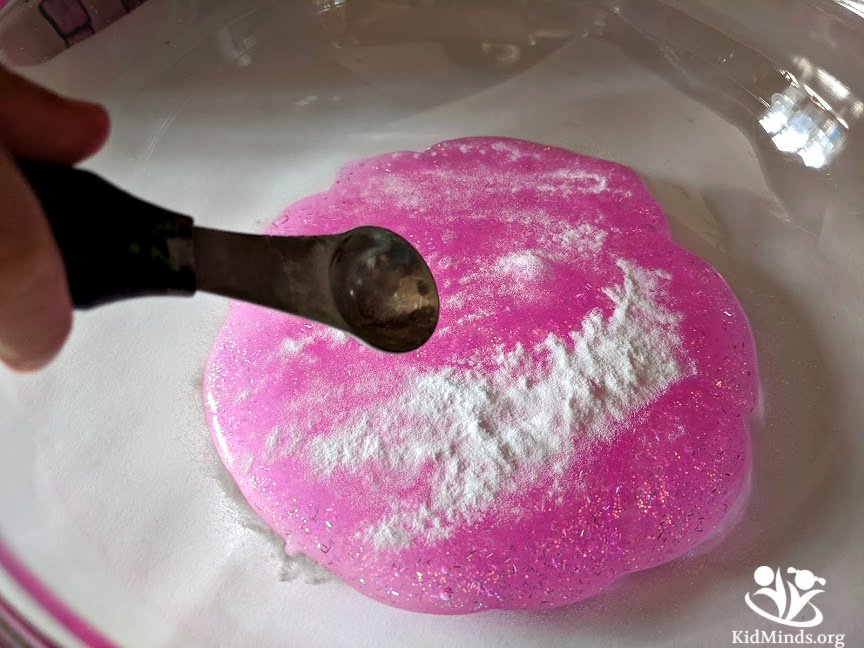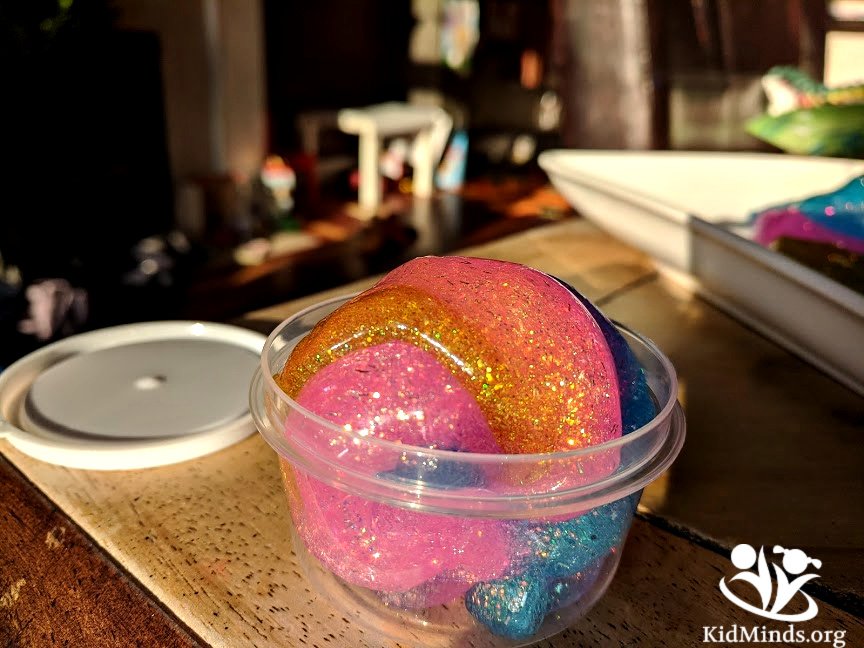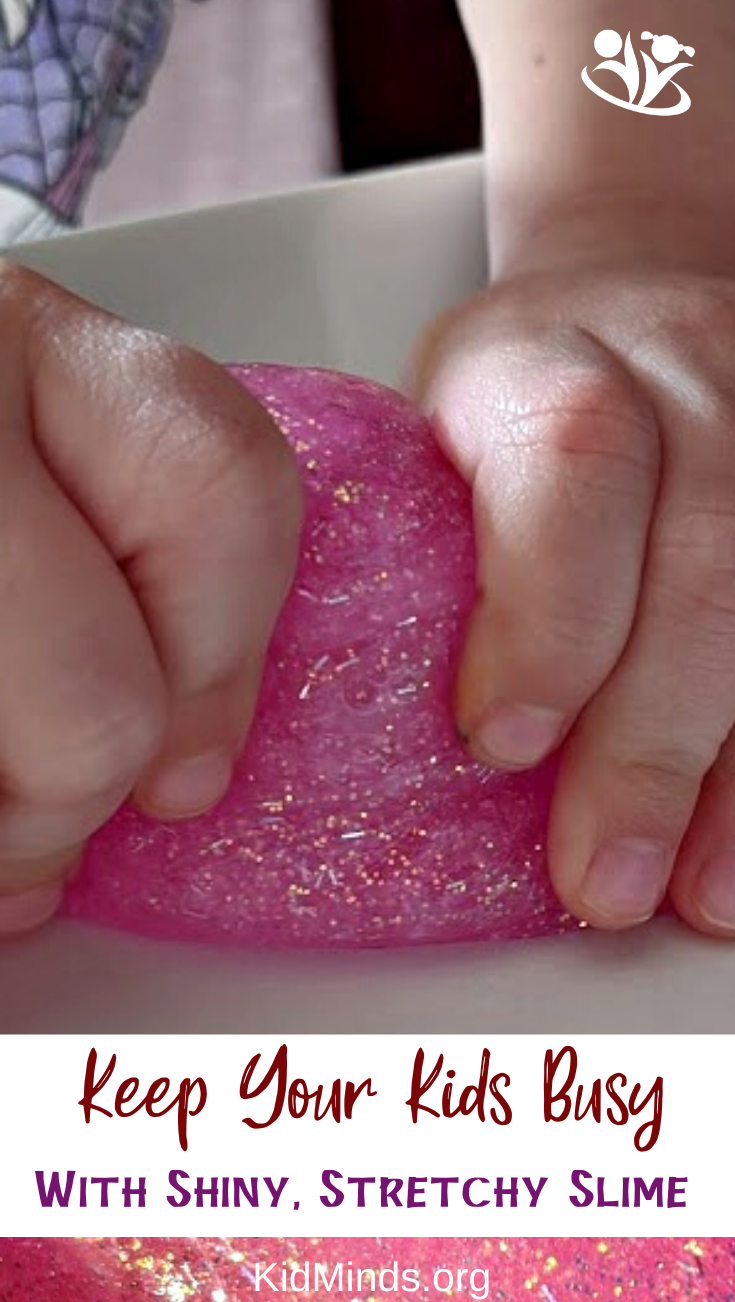Inside: Looking for an easy activity to keep your kids busy? Basic slime requires only three ingredients and takes five minutes to set up. Bookmark this page for your next long day at home.
Most busy moms have those no-brainer activities that we pull out of a hat when we need to make dinner, have a conversation with one of the kids, or just claim a few minutes to ourselves. Mine has lately been slime.
My older three kids have always been indifferent to slime. They could poke and experiment with it for maybe five minutes and then move on to better things. But I recently discovered that my youngest daughter is partial to slime.
Her favorite part is making it. She seems to be absolutely delighted by the fact that she can dump her favorite sparkly glue in a bowl, sprinkle some baking soda and mom’s contact lens solution on top, and, voila, she has “unicorn matter” in her hands.
“Unicorn matter” is what my oldest son dubbed it a few years ago, and that’s what we all call it now.

Perhaps my favorite thing about this activity is that it takes five minutes from start to finish: from the moment you start gathering the ingredients to the time you finish cleaning the scene.
Another thing I like is that it’s so easy. There is literally no way to screw it up. You can either mix soda with contact lens solution and add glue to it, or you can dump glue in a bowl and add soda with contact lens solution after. Either way, stir it all until it stops sticking to a spoon (less than a minute), and then give it a few squeezes with your bare hands to make sure it’s ready. That’s it!
Super Easy, Shiny, and Stretchy Slime
to Keep Your Kids Busy

What you need
6 oz of glitter glue (one for each color)
Baking soda – ½ teaspoon
Contact lens solution – 1 ½ tablespoons
Safety tips: Wash your hands after use. If you don’t trust your children to remain calm and keep their hands out of their mouths, mix the ingredients for them. If your children have sensitive skin, they can wear gloves. My three year old has made this slime dozens of times without my help (with me observing her), and I never worried about her safety.
NOTE: Make sure your contact lense solution contains boric acid and sodium borate. Why? Read The Science of Slime section below.
What to do
- Pour all 6 oz of glue into a bowl.

- Sprinkle ½ teaspoon baking soda on top. It’s not a big deal, but try to avoid dumping it all in one spot. Sometimes you can see clumps of baking soda in a final slime.

- Add 1 1/2 tablespoon of contact lens solution.

- Now mix with a spoon until the slime forms into a ball and then knead it a few times with your hands to get to the right consistency.

- Repeat the same steps for more colors.

Our slime is sparkly.

Our slime is stretchy.

Extremely stretchy!

And it’s great for gift giving. Just put it in a dollar store jar with a lid and add a bow.

My three-year-old is into unicorns, but I didn’t expect this! Can you see a unicorn head with a braided mane? (She learned how to braid from her older sister).

My jaw dropped when I saw what she managed to create while I was typing away on my laptop next to her at the dining room table. I added a piece of black paper for an eye!

My seven-year-old claims he doesn’t like slime, but he couldn’t resist coming over and taking a chunk of green slime to re-enact a scene from Ghostbusters movie. Remember that gooey green slime that covered everything in some of the scenes? It took him a while to pull slime into long threads and arrange it to his liking.
Note:
If you left your slime out all night and it got too hard, just wash it under running water. Or put some lotion on your hands and knead the slime.
What else could you try?
You can add:
1 tablespoon water (for stretchier slime)
More glitter
Food coloring
Now that you’ve made your own magical, rainbow-colored slime, you can go one step further and make a beautiful and calming unicorn sensory bottle.
The Science of Slime
If you worry about your kids missing out on learning opportunities while they are playing with silly slime, relax! Making and playing with slime is actually science. May I add, it’s very fun science!

If you hold slime in the palm of your hand, it feels like a solid. But put it down in a container, and it will flow, taking the shape of the container. Pound a pile of slime with your fists, and it feels hard. If you tug on it gently, it easily pulls away and you can mold it. Is it solid? Is it liquid? It’s neither. It’s a non-Newtonian liquid. It changes its viscosity (the state of being thick in consistency) when the force that acts on it changes. You can read more about viscosity in our Peanut Butter post.
Chemistry
Chemistry is a branch of science that deals with the interaction between substances. In slime, we take simple everyday ingredients, mix them to create something new, but not just anything new. It is something really cool to play with. Slime! Kids love to learn that science surrounds them in many aspects of everyday life.
Glue
Let’s start with glue. The substance that we call glue is actually polymer, a synthetic polymer with the formula (C4H6O2)n. It’s made from a combination of two main things, polyvinyl alcohol and water (water modifies the glue’s consistency). It can also have other ingredients, like ethanol, acetone, glitter, colorings, etc. As a polymer, glue consists of long flexible molecules that flow past each other like a liquid.
Borax
Another important ingredient in slime is contact lens solution. Borax is the part of the contact lens solution that we care about in making slime. Its chemical formula is Na2[B4O5(OH)4]•8H2O. Before you start mixing your ingredients, you have to make sure that your contact lense solution contains boric acid and sodium borate (both contain borax). I talk more about borax in the Green Fire post where we used borax to color fire green (it’s one of my most popular posts)!
Glue + Borax
When borax comes in contact with water in your glue, they form an ion called borate ion. Borate ions link the long polymer molecules in glue to each other, so they can’t slide as easily. You can change the consistency of slime by changing the ratio of glue to borax. We tried making stretchier slime by adding a few drops of water to our basic recipe above, and it worked.
Baking Soda
The baking soda chemical formula is HaHCO3. It helps our mixture to firm up. Baking soda is an alkaline compound that, when combined with an acid, will produce carbon dioxide gas. Boric acid is a very weak acid, so any reaction won’t be observable to the naked eye. However, don’t make slime in a small, poorly ventilated space.




[…] So why is Borax so critical? What even is Borax? Check out my expanded explanation in this Slime post. […]